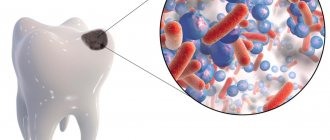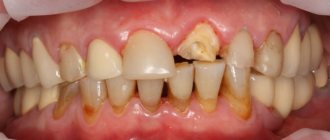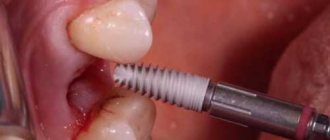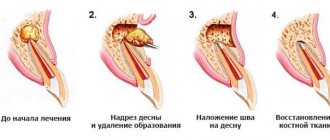If you think that dentists never tire of repeating the importance of preventive examinations and timely treatment of caries and gum inflammation just for the sake of advertising their profession, you are mistaken. Inattention to the health of your own teeth and vain fears of dental treatment can ultimately lead to complications, the treatment of which will be both difficult and expensive. A striking example of such a complication is dental granuloma - a pathological formation that occurs in the root part of the tooth.
In the early stages of its development, granuloma does not show itself with any noticeable symptoms, but as the tumor grows and becomes inflamed, severe pain in the tooth may appear, which cannot be relieved with tablets from the pharmacy. It is possible to remove a granuloma and save a diseased tooth only in dentistry and there is no need to delay contacting a doctor, because an untreated granuloma can lead to the development of serious complications, including osteomyelitis, general infections of the body and even cancer.
In this article we will tell you:
- What causes dental granuloma?
- Symptoms of dental granuloma;
- How is dental granuloma treated?
Also in the article you will find information on the prevention of dental granuloma and prices for treatment/removal of dental granuloma in Moscow.
Granuloma and cyst: what do they have in common?
To summarize, all granulomas are divided into simple and complex. The first type is characterized by a slight compaction of granulation tissue without the release of purulent exudate. Developed forms have a pronounced focus of inflammation and large sizes (up to 10 millimeters in diameter). Some experts do not share the concepts of cyst and granuloma. This needs to be sorted out. A classic granuloma does not have clear boundaries and shape, while a cyst is a capsule with purulent fluid, much larger in size, usually with less pronounced symptoms. On the other hand, a cyst is a developed form of granuloma, i.e., in fact, its more complex type.
COMPLICATIONS
Untreated granuloma leads to:
- To complete loss of a tooth. This happens due to complete destruction of the root. As a result, soft tissues are drawn into the inflammation process, in which pus accumulates.
- Osteomyelitis of the jaw.
- Formation of a dental cyst.
- Cancerous tumors.
- Infection of other organs and the development of sinusitis, pyelonephritis and infectious myocarditis.
- If pus gets into the skull, meningitis, encephalitis and inflammation of the peripheral nerves may begin.
- The appearance of migratory granuloma. Manifests itself in the form of protrusion of the facial skin. The disease also appears in the form of abscesses and fistulas in different places.
How does the treatment of a cyst differ from the treatment of a granuloma?
Many experts distinguish three forms of the disease: granuloma, cystogranuloma and cyst. Depending on the type, a technique is selected and a detailed treatment plan is drawn up. It is believed that the initial form of granuloma can be treated conservatively, and to get rid of the cyst one cannot do without surgical intervention. This statement is partly true, but when drawing up a treatment plan, you must first of all evaluate the clinical picture. A large cyst (more than 8 millimeters in diameter), which affects the roots of healthy teeth, has penetrated the maxillary sinus, caused a serious abscess or osteomyelitis, and must definitely be removed. Granulomas and cystogranulomas of small sizes in the absence of extensive inflammatory processes with the spread of purulent exudate are today quite successfully treated with antibiotics or endodontic manipulations.
DIAGNOSTICS
Only a dentist can make a correct diagnosis based on an x-ray. In the image you can see a small darkened area near the root of the tooth.
Radiovisiography can also be done in the hospital. This is a type of x-ray with less radiation. The results are assessed not in the picture, but on the monitor screen. For this reason, such a survey is often called digital.
Granuloma is best recognized at the first stage. It is often detected during the treatment of other dental diseases. In addition, doctors pay attention to abnormal swelling of the gums, which is very painful. Also, the protrusion of bone near the apex of the tooth comes to the attention of doctors.
A special category includes patients with installed crowns and pulpless teeth. Granuloma occurs much more often in such people. Doctors pay special attention to these people.
Tooth granuloma: antibiotic treatment of simple forms of the disease
As already mentioned, granuloma at the initial stage responds well to treatment, since it is only a small nodule of connective tissue. For successful healing, as a rule, it is enough to undergo a course of treatment of dental granuloma with antibiotics. For this purpose, drugs from the group of tetracyclines (Doxycilline), lincosamides (Lincomycin) and penicillins (Amoxiclav) are usually used. The type of drug and treatment concept depend on the degree of pathology and the doctor’s recommendations. It is believed that for the simplest forms of granuloma without visible signs of inflammation, antibiotics in ampoules are prescribed, and to treat granuloma in a more advanced stage, injections are necessary. In addition, the doctor usually prescribes antimicrobial and anti-inflammatory drugs, as well as the use of antibacterial gels and ointments.
Causes and development factors
Granuloma annulare in children can appear for various reasons, which have not yet been fully established. The provoking factor is a focus of chronic infection in the form of rheumatism, tonsillitis. The presence of diabetes mellitus, allergic diseases, and metabolic pathologies increases the risk of development. In children, a lot depends on the immune system. If there is a failure, the development of the neoplasm will be started. Pyogenic granuloma in a child occurs due to a pyococcal infection. The reason for the development lies in skin injuries, due to which infection gets into the wounds. It is localized mainly on the face, legs, fingers and arms. Eosinophilic granuloma is rarely found in young children. The peak incidence occurs between 5 and 10 years. The causes of such granuloma in a child are ambiguous. The question still remains open. Scientists suggest that immunopathological processes are the basis.
Stages of granuloma development
From the moment of inception, the neoplasm goes through 4 stages. At the initial stage, there is an accumulation of cells with a tendency to phagocytosis. At the second stage, the process of their rapid growth begins. The third stage is characterized by the transformation of phagocytes into epithelial cells. At the last fourth stage, granuloma formation occurs directly.
Treatment of granuloma at home
Can dental granuloma be treated with folk remedies? Yes, but only as an addition to the main therapy. Treatment with folk remedies for granulomas on the root of a tooth usually includes rinsing with various tinctures and decoctions. The most common of them are tinctures of calamus and propolis, decoctions of chamomile and calendula, as well as regular soda solution. Often, the use of folk remedies is prescribed after surgical treatment of cysts and granulomas in order to reduce the inflammatory process and pain in the postoperative period.
Symptoms of granuloma
Often the chronic granulomatous form of periodontitis is asymptomatic; sometimes patients complain of minor pain when biting and discomfort in the area of the diseased tooth. When granuloma grows, the following symptoms occur:
- swelling and redness of the gums:
- darkening of the affected tooth;
- increased toothache, its bursting nature;
- sharp sharp pain in the tooth in the morning, immediately after waking up;
- discharge of pus from the subgingival space;
- development of periostitis - inflammation of the periosteum (patients call it gumboil): the gums swell greatly, the swelling spreads to the lips and cheek; toothache radiates to the ear, temporal region, eye; a fistula tract may appear through which pus is released;
- increase in body temperature to 38°C and above;
- headache;
- feeling that the tooth has grown and become taller when biting;
- general weakness.
Factors contributing to the manifestation of symptoms of the disease:
- a sharp change in climatic conditions (weather change, moving to an area with a different climate);
- stress;
- hypothermia of the body;
- previous colds;
- physical stress.
Tooth granuloma: treatment of medium forms
To treat advanced forms of granuloma, endodontic techniques are used, which involve opening the root canal cavity. Treatment of diseases at this stage takes several stages and is carried out over a number of visits to the doctor.
Main stages:
- tooth treatment, opening and antiseptic treatment of dental canals;
- antibiotic-based medications are placed into the canal cavity;
- after the required period has expired, the canal cavity is opened again and filled with calcium-containing paste;
- At the final stage, permanent canal filling and tooth restoration are performed.
Separately, it is necessary to mention two modern physiotherapeutic technologies for the treatment of granuloma, which are successfully used in endodontics.
- Depophoresis.
This is cleaning the canal cavity from pathogenic microorganisms using a copper suspension. Under the influence of electric current, the smallest particles actively move throughout the entire canal cavity and destroy the source of inflammation. - Dental microscope.
A very useful and expensive device that allows for the most precise manipulations and provides a more predictable treatment result.
Traditional methods and treatment at home
The use of traditional methods in the treatment of granuloma can lead to complications and irreparable consequences.
Under no circumstances should hot compresses be applied to the cheek on the side of the inflammation: this will accelerate the spread of pus. Even if you know the names of antibiotics used in the treatment of tooth root granuloma, you should not take them yourself. Treatment methods should only be chosen by a doctor.
The only thing that can be done while it is not possible to get an appointment with a doctor (for example, symptoms appeared late in the evening) is to take a Nurofen or Ketanov tablet to eliminate the pain.
You need to understand that the development of inflammation occurs inside the root canals and in the jaw, which cannot be reached by any folk remedies, and only the help of a specialist will help save the tooth.
Laser treatment of dental granuloma
Laser treatment is considered one of the most advanced in medicine and is also used in dentistry. It is believed that treatment of dental canal granuloma with a laser allows you to do without the use of drugs, since the beam destroys the accumulation of granulation tissue and destroys all pathogenic microorganisms. This impact has its supporters and opponents. Fans of laser treatment assure the maximum effectiveness of the technique and provide statistical data demonstrating the effectiveness of this method. On the other hand, the cost of treating dental granuloma with a laser is higher compared to classical endodontic manipulations; the use of certain medications is still required, and in case of non-standard structure of the root canals (in particular, with severe curvature), the use of a laser is less effective. It can also be used during direct surgical intervention in the process of processing and removing tissue. This reduces the invasiveness of the operation, but increases the final cost of treatment.
Why does a dental cyst appear?
What is the prerequisite for the appearance of such an unpleasant disease - dental cyst:
- physical trauma;
- periodontitis, peritonitis, pulpitis - inflammation of the soft tissues around the tooth;
- residual effects after diseases of the nasopharynx - ARVI, complications after influenza;
- decreased immunity;
- advanced caries process;
- poor oral hygiene;
- development of infection in the root canal;
- poorly placed crown, poor quality filling;
- the appearance of problems with the wisdom tooth.
Tooth granuloma: treatment of severe forms
Treatment of complex forms of granuloma, in particular large cysts, is possible only using surgical techniques. The same applies to the treatment of this disease after unsuccessful manipulations that caused numerous perforations of the tooth root. Below are the main granuloma removal techniques.
| Complex granuloma on the root of a tooth: treatment | Description of the technique |
| Cystectomy (apex resection) | The doctor removes the granuloma along with the root tip, after which the canals are filled. Before the procedure begins, it is often necessary to drain the pus, which requires an incision in the gum and a certain time for the fluid to completely drain out (on average 2-3 days). To restore bone tissue in the area of surgery, the use of osteoplastic materials is required. |
| Hemisection | The granuloma is removed along with part of the root and crown, after which the tooth is restored. This is often how granulomas are treated when a tooth canal is perforated. |
| Separation | The technique is applicable exclusively to molars. The tooth is divided into two parts, after which the doctor carries out all therapeutic and restorative manipulations through the resulting gap. |
| Removal of a tooth | An extreme measure that is resorted to when all other methods are impossible for a number of reasons. These include severe damage to the tooth, as well as numerous perforations or a vertical crack in the root. |
Important:
Treatment of tooth granuloma under the crown requires extraction and subsequent replacement of the orthopedic element. If after treatment of granuloma the tooth hurts and the severe pain does not subside after several days, you should consult a doctor.
Features of prevention
The main condition for the prevention of dental granulomas is timely assistance from a dentist when caries occurs. You should not allow severe tooth decay or the development of pulpitis. The peri-root tissues are healthy until the pulp becomes inflamed. Therefore, if symptoms of caries or pulpitis appear, it is important to immediately consult a doctor.
Endodontic treatment also increases the likelihood of developing periodontitis. Therefore, it is better to eliminate caries in the early stages and avoid the need for root canal filling. If this is unavoidable, it is important to carefully choose a dental clinic - the professionalism of a specialist will help eliminate possible mistakes and prevent complications.











